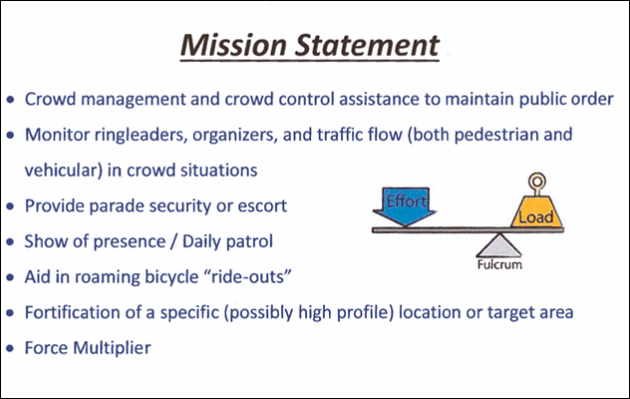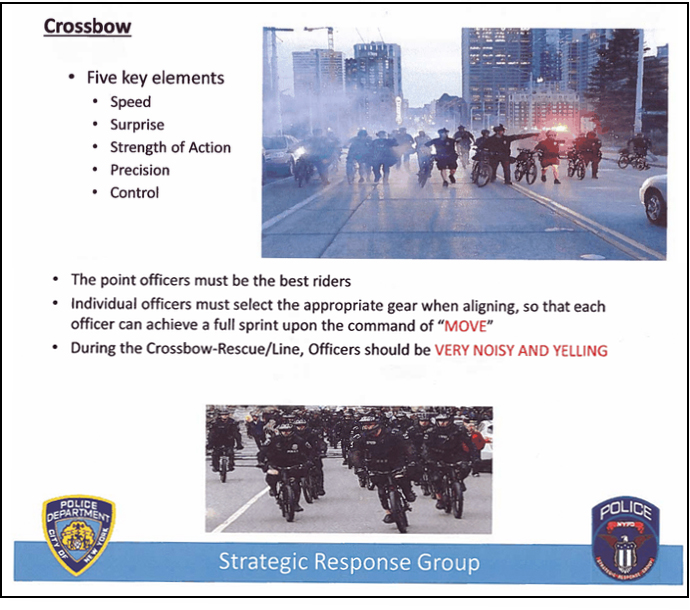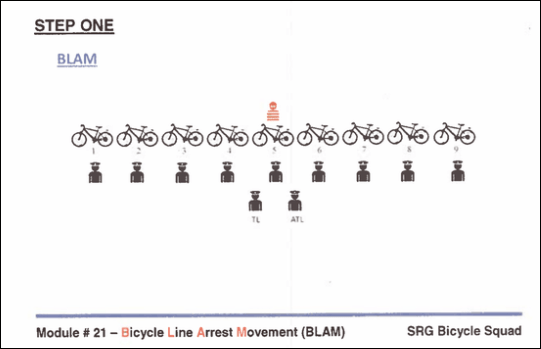The notoriously aggressive NYPD officers who used their bikes as weapons to violently stop peaceful protesters last year were merely following their own handbook, according to a new bombshell report from The Intercept.
In January, Attorney General Letitia James filed a federal lawsuit against the NYPD for its use of excessive force during months of summer protests that began after the police killing of George Floyd in Minneapolis, accusing the NYPD of violating the state and U.S. constitution by “repeatedly and without justification” using “batons, bicycles, Oleoresin Capsicum spray (also known as pepper spray), body strikes, overly tight zip-ties, cars, and Tasers.”
A month earlier, the Department of Investigation issued its own report, accusing the NYPD, and specifically its controversial Strategic Response Group — dubbed “the goon squad” because of its aggressive conduct, according to The Appeal — for abusing its power and misuse of force; and a coalition of local pols demanded that cops stop using their bicycles as weapons.
“The weaponization of bikes by officers to kettle, shove, and hurt protesters...was appalling. Bikes are for riding, not for hitting people,” Brooklyn Council Member Brad Lander said at the time.
But who is to blame — the individual officers of the SRG, or the NYPD brass that hands down the orders? That answer becomes more clear, thanks to The Intercept, which obtained the Strategic Response Group’s own 173-page guide that reveals the alleged violation of protesters’ rights was not a one-off, but very much a part of the officers' training.
The SRG squad, founded as an anti-terrorism and protest tactical unit by former Commissioner Bill Bratton in 2015, is often assigned to events like Black Lives Matter protests, the 2017 Women’s March anti-Trump protests, and bike ride-outs — like the one back in April, 2019, when dozens of armed cops intimidated young riders, confiscated their bikes, and wrote tickets to youths for not having bells on their bicycles.
SRG officers often prepare for such events by scouring the social media profiles of known attendees and organizers so they know who to target, according to the report and guide (indeed, cops arrested Shardy Nieves for an outstanding open container warrant at the 2019 ride-out).

Here are five takeaways from the "Goon Squad's" own guide:
Strike vs. Push
Apparently there is a difference between gently shoving one's bike into a protester and violently swinging it at him or her, according to the guide. Cops must know "the difference between a strike and a push with a bike or baton,” the guide says.
But do they? During last year's protests, cops were caught on camera using their bikes to brutalize peaceful protesters in Manhattan — just one of the first of many similar instances of police brutality, which James said in her lawsuit was deployed "unjustifiably."
"In response to these largely peaceful Protests, NYPD Officers effected mass arrests without probable cause, unjustifiably deployed pepper spray, batons, and other force against protesters, and targeted and retaliated against First Amendment activity so frequently and pervasively as to constitute customs or usages of the NYPD," James wrote.
And that same practice continued months later when the same squad also violently rammed their bikes into Public Advocate Jumaane Williams during a November protest for Black trans liberation, according to multiple videos taken by reporters at the scene.
“NYPD was trying to clear the street to make an arrest. Aggressively,” Williams tweeted at the time. He also decried the “lack of leadership” inherent when officers act so brutally.
NYPD was trying to clear the street to make an arrest. Aggressively.
— Jumaane Williams (@JumaaneWilliams) November 6, 2020
Officers then appeared to begin setting up for mass arrests— we intervened to try and de-escalate and prevent that.
Most importantly, there seems to be a lack of leadership when the City needs it the most. https://t.co/ij7xxwCwT5
Levels of Force
The squad learns five levels of force that it can deploy against protesters, and which ones will require a review by higher ranking officers, and potential resulting discipline.
The first is called De Minimis, which is merely meant to "separate, guide, or control" a crowd. It does not need to be reported unless it causes injury.
Level 1 is force that causes physical injury, like by a hand or foot strike. It must be reported and reviewed by a higher-ranking officer.
Level 2 is when an officer intentionally strikes a subject with an object, like a baton or bike. It’s “prohibited,” according to the guide, and must be reported and reviewed by either a Captain, Executive, or Commanding Officer
Level 3 is considered deadly physical force. It must be reviewed by the Internal Affairs Bureau, or IAB.
And Level 4 is when a cop fires his or her gun. It must be reviewed the investigation division.
It's unclear what levels of force the NYPD was executing last summer, or what actions resulted in investigations (if any); the Attorney General's report does not specify what levels of force cops deployed, and the NYPD did not respond to a request for comment, telling Streetsblog to file a Freedom of Information Request.
Zone of Safety
If members of the SRG squad feel threatened, they are trained to spray anyone who comes near them with pepper spray — which they did many times over the summer, even to local pols, including Assembly Member Diana Richardson and State Sen. Zellnor Myrie, both of Brooklyn.
The guidance is pretty vague on what constitutes a "threat," pretty much giving cops the freedom to spray indiscriminately.
"Utilized when danger is perceived or threatened to the bicycle squad and there is no alternative to ending the threat or danger, the MK9 OC spray will be utilized to create a zone of safety for the bike squad," the guide says.
Pain. pic.twitter.com/5ZPPTGTUfP
— Senator Zellnor Y. Myrie 米维 (@zellnor4ny) May 30, 2020
Formations and Arrests
Members of the SRG learn different formations in which to ride through protests and certain events, and which formations are best for arresting a “target.”
The most basic are the line formation, and rolling line formations for crowd management; then there’s flanking, which cops use to change the direction of a march.
And one of the most common formations at protests throughout last summer was the Mobile Fence Line, where the officers make exactly what it sounds like — a fence — with their bikes, crowd-facing. They should be shouting “move back," according to the guide. It’s used to “gain ground and compliance."
At Barclays for #GeorgeFloyd protest pic.twitter.com/JRGZkaQn1k
— Julianne Cuba (@Julcuba) May 29, 2020
The SRG squad used that formation during the July, 2019, "die-in" in Washington Square Park, when thousands protested the number of cyclists deaths that summer.
Standoff between police and cyclists now after the #bikenyc die-in at Washington Square Park. pic.twitter.com/i7hyA9VCDS
— Julianne Cuba (@Julcuba) July 9, 2019
Another formation that is often used for arrests is the Crossbow Line, which has five key elements: speed, surprise, strength of action, precision, and control, according to the guide. Officers should be “VERY NOISY AND YELLING,” it says.

And then there’s two different types of arrests:
The first is Bicycle Line Arrest Movement or BLAM (there's also an E-BLAM, which stands for Emergency Bicycle Line Arrest Movement).
Officers are taught to “clinch maneuver of subject over bicycles,” “clinch subjects head into your chest (do not block airway) and step back dragging subject over bicycles and take into custody.” Probable cause should be determined before, the guide says.
The guide also makes clear that officers should not put anyone in a choke-hold.
"NOT A CHOKE HOLD, DO NOT BLOCK AIRWAY," it says.

Be One With Your Bike
And last, but not least, the NYPD tells squad members to feel connected to their bikes in order to achiever their best policing performance.
“In order to be a confident rider, you must become one with your bicycle,” the guide says.
Prior to every ride, the guide tells cops to recite their ABCs: A is for Air in tires; B is for Brakes; and C is Crank-set and chain. This is a lesson that not just cops, but everyone who rides a bike, should follow.
“Prior to that challenge, the individual should set up his or her bicycle to work for them and not against themselves. Having the ability to make adjustments to your bicycle will change the ergonomics of rider position and be able to use the bicycle's geometry to your advantage,” the guide states.
The five lessons outlined above, which cops must learn throughout their training, is only more evidence of the fact that the problem is engrained in the NYPD's culture as whole — it's not something that any more training, or reform, could fix, an advocate told The Intercept.
“The SRG is a symbol of the hyper-aggressive, militarized, unaccountable police violence in New York City, but that’s not exclusive to the SRG,” Joo-Hyun Kang, director of Communities United for Police Reform, told the publication. “We have to understand this is part of the fabric of how the NYPD has historically treated protests and has historically treated Black, Latinx, and other communities of color.”






